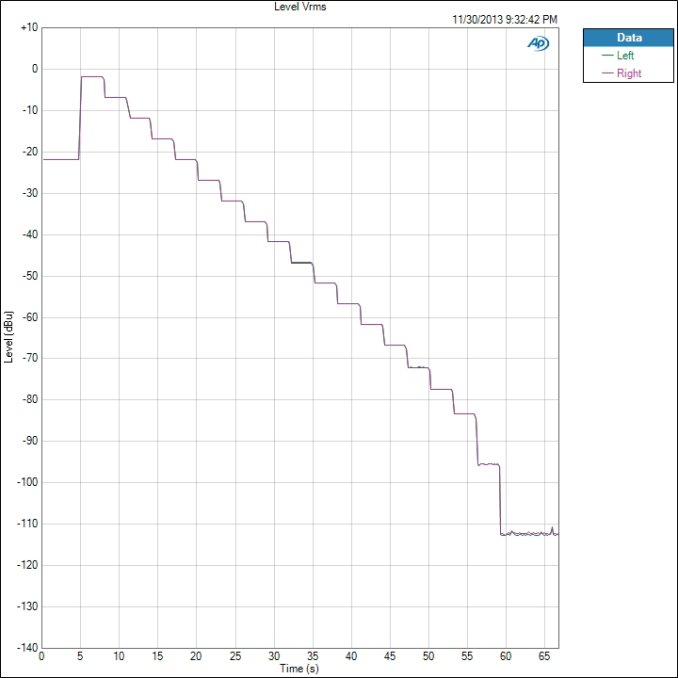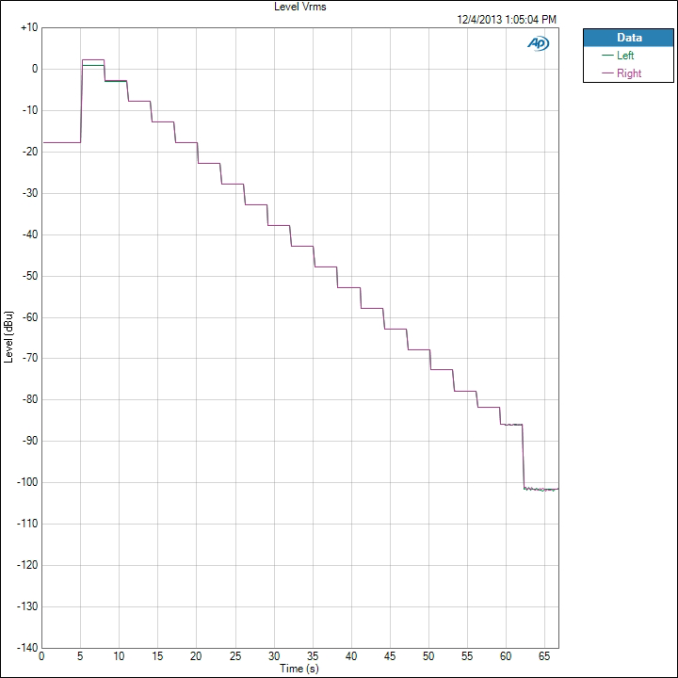Smartphone Audio Quality Testing
by Chris Heinonen on December 8, 2013 5:15 PM EST- Posted in
- Smartphones
- Audio
- Mobile
- Tablets
- Testing
Dynamic Range
The dynamic range of the phone indicates the difference between the loudest possible sound and the background noise. The more residual noise in the background, the lower the dynamic range. Phones with more powerful amplifier sections will typically produce a greater dynamic range. The residual noise level is often constant, so as the overall volume level increases the difference between the music and the noise increases as well.
The best performer here is the iPhone 5 again, with 92.214 dB of range. The worst is the Nexus 5 with only 89.332 dB. A difference of 3 dB is not something I would concern myself over. If we see a phone or tablet that drops down below 80 dB then I will start to show more concern.
Crosstalk
Crosstalk, like dynamic range, is just a number here. This is the measurement how much signal leaks from one channel into another. If an instrument should only be in the right ear, some of that signal will leak into the left ear, but we want that as low as possible. The results are expressed in -dB, or how much quieter one ear is than the intended ear.
On the Note 3 we see a wonderful crosstalk measurement of -117.2 dB so the sounds in one ear are -117 dB quieter in the other ear. This makes them impossible to hear. The worst is the iPhone 5, with only -75.624 dB of isolation.
Stepped Response
The stepped response uses a 1 kHz 0 dBFS tone but measures output level from maximum volume to minimum volume. We can see how large the volume steps are and how many there are. It doesn’t produce a number we can use, but it ties back into our other results. For a good example, we can look at the Note 3.
We see steps that are around -5 dBu each. The final level is muted and just the background noise of the device. Each step is clean and even but as we get lower and lower we see noise start to intrude. This is the background noise starting to become audible in the signal. The flatter the levels are, the quieter it will be. Now, let us look at the Nexus 5.
Notice at the very top how the right and left channels do not overlap. That is the clipping we talked about at the very beginning. It isn’t until the 4th volume setting that the level difference is down to nothing. Because of this, I would consider the top 3 volume settings of the Nexus 5 as ones that should be avoided. They each have enough THD+N introduced into them that it will sound poor, and one ear will be louder than the other.












188 Comments
View All Comments
sonci - Friday, December 13, 2013 - link
Thanks Anandtech,Nice for doing these reviews, one of my top reasons for choosing a smartphone is audio quality, and im not talking about the voice of my wife, but the music reproduced through earbuds.
Please keep going testing at full volume not only for those who use them with an external integrated, but because that's the right way, if manufactures bost the volume and allow clipping than thats a flaw, also if a phone measure good at full volume than its super good at low volumes, you also can measure them at a specific sound pressure levels, though the difference should be small, but anyway these are not reviews for the casual listener,
and Yes unfourtunately iphones sound very good.
I also would be interested in measuring some old and new mp3 players, though in that case its different to be objective, because for a n audio player SQ is a major selling point, but I dont see Lumia selling more than Galaxie because of better SQ.
If you cant find any old mp3 player, we are crazy enough to send them to you, hoping to have them back once tested.
Thanks
Mokona512 - Saturday, December 14, 2013 - link
Can you do a comparison of smartphones and dedicated mp3 players?for example my sandisk sansa running rockbox firmare gives much better audio quality than my smartphone, especially when driving my akg k240.
cb474 - Saturday, December 14, 2013 - link
I appreciate the sophistication and thoroughness of this review. But I have to say that I have never had a smartphone where I've thought, boy this audio quality is unacceptable. Especially with earbuds or plugged into an external system. Unless you're an audiophile, they all seem pretty good to me.Speakers on smartphones are obviously another story.
But to me the real issue is call quality, including earpiece volume, sound quality of the mic (for one's caller), and especially noise cancellation. Anandtech, thankfully, covers noise cancellation in its reviews with a meaningful babble track test. But I wish there were still much more focus on call quality. There are real differences when it comes to call quality, even amongst flagship phones, and this is an area in which, on a daily basis, I experience frustration. It's amazing how much the "phone" functionality of something that is after all phone is ignored.
kevmitch - Sunday, December 15, 2013 - link
I agree. Excellent article. I hope to see more like it and on the subject.I wouldn't mind the "sensational" scales so much if they were at least used consistently. It was difficult to compare for example the THD FFT responses by tabbing between them in browser windows because the scales aren't the same.
While the max volume should really be set correctly, it would nevertheless be interesting to see the THD FFT for what SHOULD have been the max volume (i.e., a step or two below the G2). I have to say I'm a lot less excited about getting a Nexus 5 now - the Galaxy 4 looks much more appealing in spite of the significant price increase. These results even had me consider getting an iPhone for about half a second.
vang024 - Monday, December 16, 2013 - link
Sorry, but shouldn't you be using lower impedance headphones? The grado is rated at 32 ohms and the K 701 is rated at 64 ohms. The grado might be ok for portable electronics use but the K 701 is more difficult to drive than the 64ohms it is rated at. Not only that, but they are both open headphones which leaks tons of sound and not prefer for anybody using a portable electronic as their music source.I think you have to inform the reader the difference between a closed and open headphones(assume they don't know the difference). I see people purchasing a HD600/650 or an AKG Q702 and complains about the sound leakage when these headphones are design to do so. Most of the time people will purchase headphones like a B&W P5/P7, KEF M500, Bose, or Beats for portable use because they are closed design with low impedance. I would say those are targeted for smartphone users.
I am not saying you shouldn't test smartphone devices with higher impedance headphones, but The Grado and AKGs are not designed for the average joe who don't know much about headphone technologies.
bogdan.anghel - Thursday, December 19, 2013 - link
i listen to a lot of music on headphones, i own a S3, and i want to upgrade to S4 and everywhere i see a review the audio quality and power is very bad. should i go with the HTC One? audio and design is very important to me. (i love the S4 but in terms of audio and design, it's crappy) do any of you guys test or compare those 2 on the same headphones?manveruppd - Friday, December 20, 2013 - link
It's great to see you pushing the boundaries of phone reviewing by testing things that noone else bothers to, and with a scientific precision no one else can match, but i do have a couple of suggestions:firstly, how about also testing the quality of the built in speakers, rather than just the headphone amp? after all, sound qquality in calls is an important consideration when buying a phone. as for the loudspeaker, while i agree that noone except annoying teenagers would listen to music through their phone's loudspeaker, a lot of people use the speakerphone function on their phones regularly, so it's a legitimate area of testing.
secondly, i wonder if it's fair to test all phones with a set of ear buds designed for one phone? if i were a manufacturer i would make sure to bundle a set of buds that sound good driven by the headphone amp i built into my phone, and i would expect it not to do as well with a higher impendance pair of headphones,for example. so to test on apple buds is probably not quite fair on other devices. i would simply pick 3 pairs of headphones, one each of high, low, and medium impendance, made by some reputable audio brand rather than by the manufacturrer of one of the tested devices.
good job though, looking forward to future review
synaesthetic - Thursday, December 26, 2013 - link
output impedance please!seshraj - Wednesday, January 1, 2014 - link
Thanks for another wonderful post.One suggestion to include one Xperia smartphone in your list to test. I personally use an discontinued model Arc S for close to 3 years now and have always been pleased with the bravia audio quality and output, sunlight visibility and camera. I am not a techie or a heavy user of a smartphone; but amazed with the audio quality of this device. I am sure the newer models like Xperia Z would have a more upgraded and better sound quality.
jcazes - Tuesday, January 7, 2014 - link
Can anyone comment on how these deficiencies translate to A2DP streaming over bluetooth? I have an LG G2 and am looking at finding something with Apt-X / aptX support (or cooking it in via a custom ROM, if possible). If the phone can't output audio properly over any channel then I don't want to waste my time.